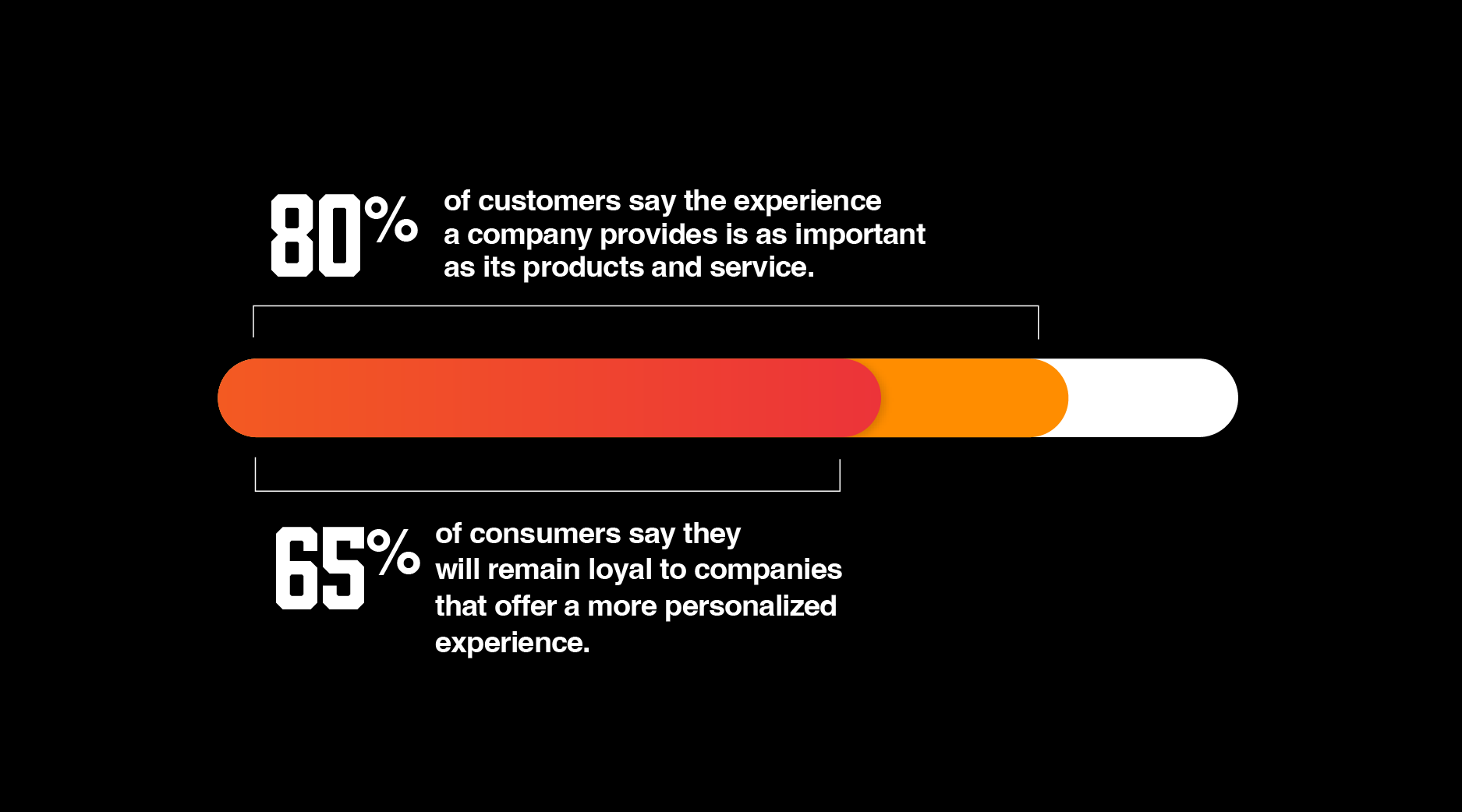“Personalization is all the rage.” If you are a marketer, especially one working in MarTech, you’ve likely heard this sentiment a lot in 2025. In truth, personalization has been a hot topic for several years. Despite its prominence, it remains hard to execute and execute well.
This past spring, I represented Simantel at the Salesforce Connection conference in Chicago. While there were several valuable takeaways, one key theme stood out: personalization.
So why is personalization still such a focus? Because it’s what consumers are expecting. Salesforce’s research highlights just how high the bar has been set:
- 80% of customers say the experience a company provides is as important as its products and service.
- 65% of consumers say they will remain loyal to companies that offer a more personalized experience.
- 64% of customers expect tailored engagement based on past interactions.
Perhaps the most striking stat though was that 92% of marketers believe their customers expect a personalized experience. So, if 92% of marketers believe their customers want these personalized experiences, and 64% of customers expect personalized experiences, why is creating personalized experiences so difficult? Most importantly, how can we break personalization down into a manageable process?
Here are six fundamental principles that make the daunting task of creating fully personalized experiences more manageable.
Principle 1: Data is King!
When it comes to personalization, the foundation of every solution needs to be built on data. Without accurate, high-quality data, it’s impossible to create truly relevant experiences. Here are three critical areas of focus:
- First-party data – First-party data is one of the most critical data pieces when it comes to personalization. First-party data refers to information collected directly from your audience through your own channels. Most likely, this will be tied to forms that you have on your website. First-party data is vital because the user provided it, meaning it is more accurate and sustainable, not to mention privacy compliant. This data is key to knowing who your customer is.
- Unified data profiles – Once your first-party data is in order, the next step is to move toward unified data profiles. Unified data profiles refer to the ability to create a single unified view of your customer by connecting disparate data sources like web, email, CRM, service, events, etc. Unified data profiles break down the silos that exist within your data and allow for a holistic view of the customer and their activity. This can be accomplished through Salesforce Data Cloud or other Customer Data Platforms like Adobe Real-Time or Treasure Data. Unified profiles allow you to create personalized experiences across multiple different channels where a customer may interact with you.
- Behavioral tracking – Once you’ve built your data foundation on first-party and unified data, the next step is to leverage behavioral data. Behavioral data is collected via Software Development Kits (SDK) or other tracking scripts embedded on your site. They allow the personalization platforms to collect data on how the user is interacting with the site (pageviews, scroll depth, time on page, downloads, cart activities, key events, etc.) and leverage that data to create personalization in real-time. Additionally, SDKs can be used to track behavior of anonymous users, that can then be leveraged and tied to known users, once the anonymous user converts to a known user via logging in or filling out a form.
Related Content: Analytics Maturity Roadmap: A Guide to Better Marketing Reporting
Principle 2: Segment Your Data
Once you have the data, the next key step is to focus on segmenting it. Without segmentation, your data will just be … data. Segmentation is what turns data into actionable data. Segmenting your data will allow you to move from a one-size-fits-all approach to tailored content, journeys, etc. How you segment your data can really depend on what data you have collected. Common data segments are:
- Demographic: role, company, geography
- Behavioral: website actions, email engagement, services inquiries
- Lifecycle: marketable contact, lead, customer, advocate
- Predictive: personalized AI-driven segments based on next best actions or products
Taking your segments one step further allows you to map your segments back to known personas which can help tie your actionable segments back to your messaging strategy.
Principle 3: Content Shapes Experience
Now that we have defined our segments with actionable data, the next step is to focus on content. That said, principle 3 and principle 4 (execution) are very closely tied. That’s because to develop good content, we must have the personalization execution plan in mind. Think of it this way: personalization succeeds when the content is aligned with the context. Personalization platforms personalize content by swapping pre-built content based on different triggers, events and segmentation. Therefore, the personalization platform can only personalize based on the content it has been provided; it cannot create new content on the fly.
Related Content: Inside Content Strategy: What It Is and Why You Need It
Principle 4: Execution Enables Impact
Execution and content go hand in hand. You can’t do one without knowing the other. When it comes to executing personalization, there are so many ways you can do it. Many of the capabilities will come down to your marketing automation or personalization platform.
Marketing automation platforms (Salesforce Marketing Cloud, Marketo, HubSpot, Eloqua, etc.) are used to manage personalization in emails, SMS and some web content. Some examples of marketing automation personalization include triggered nurtures, dynamic content or different lifecycle campaigns.
Platforms like Salesforce Marketing Cloud Personalization, Adobe Target and Optimizely enable deeper real-time personalization on the web or email. They can deliver dynamic banners, product recommendations, slide-ins, personalized CTAs and next best actions. Unlike marketing automation platforms that primarily use first-party and unified data, these platforms thrive on using SDKs and behavioral data.
Principle 5: Go Slow
At Simantel, we recommend a “crawl, walk, run” approach to building out personalization. Personalization can feel daunting to stand up, so focusing on key fundamentals and quick wins is key to building momentum. Here’s an example of what this can look like:
- Crawl: Focus on the basics
- Start by focusing on first-party data, simple segments, modular templated content and simple execution.
- Email: Implement dynamic content or triggered journeys like cart abandonment.
- Web: Use basic personalization like swapping hero banners or personalized welcome back greetings.
- Start by focusing on first-party data, simple segments, modular templated content and simple execution.
- Walk: Layer in more data and content
- Focus on building more robust data via unified data sources and move to deeper segments by looking at site behavior, all while building out a content library that can support more robust use cases.
- Email: Align email engagement to site experience.
- Web: Create dynamic CTAs or tailored content recommendations based on the contacts segment or site engagement.
- Focus on building more robust data via unified data sources and move to deeper segments by looking at site behavior, all while building out a content library that can support more robust use cases.
- Run: Fully embedded experience
- Focus on real-time identity resolution and layer in predictive actions.
- Email: Build fully dynamic emails that are triggered in real time based on the user’s site engagement.
- Web: Tailor content based on a contact’s likelihood to buy or create robust “next best actions” to move contacts through the funnel and encourage longer site engagement.
- Focus on real-time identity resolution and layer in predictive actions.
Principle 6: Test and Learn
Personalization is a phenomenal tool for creating highly relevant experiences for customers, but it is not “set it and forget it.” If you are not continually monitoring the performance of campaigns and optimizing, your campaigns will likely stall. The reason for this is that customers, like data, change over time. Customer behavior and preferences can change from one month to the next. Therefore, it is important to create a continuous feedback loop focused on tweaking and testing different scenarios to ensure your content and experiences still resonate.
Personalization is not a single project. It is a journey that companies embark on. We have teams at Simantel that can help with every facet of the journey from data optimization, to content and execution and all the way to testing and learning. If personalization is part of your roadmap to create better experiences for your customers, let’s connect!




